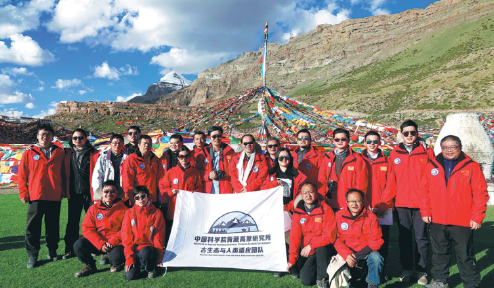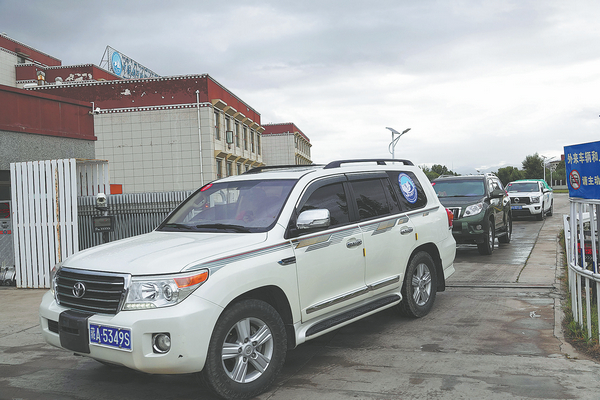By Wang Qian Source:CHINA DAILY 2023-11-20

Researchers conducting a summer scientific investigation at the Gadpaserul site in Ngari prefecture, the Xizang autonomous region. This is a graveyard dating back 3,000 to 3,600 years, which is evidence of an economy reliant on herding and hunting, and has shed light on the Neolithic and Early Metal ages in the region. SUN ZIFA/CHINA NEWS SERVICE
Findings cement region's importance in the development of Chinese civilization, Wang Qian reports.
In the past three years, the Xizang autonomous region has emerged as one of the epicenters for archaeological exploration in China, leading to a wealth of knowledge being unearthed that has enriched people's overall understanding of the nation's ancient roots.
A recent conference on major new findings held in the region unveiled a trove of discoveries and the most recent progress in local archaeological operations.
Wang Junzheng, the region's Party chief, said at the conference that local government officials and archaeological authorities would enhance cultural heritage preservation, while proceeding with the foundational work, including the continuous region-wide cultural relic surveys, the improvement of related regulations and rules, regular safety checks and the crackdown on relic-related crimes.
With intensified archaeological research in recent years, he emphasized the importance of scientific excavation and research of the historical heritage sites in the region and called for further effort to bring these ancient cultural relics alive through various means, including museum construction, which will help foster the creative transformation of traditional culture.
From 2020 to the end of last year, the region has conducted more than 90 archaeological survey and excavation projects, a testament to the region's profound cultural significance. Among them, 50 were unearthed during infrastructure construction programs, such as rail and road building; 10 were rescue excavations — unearthing artifacts, environmental remains and structures that were in danger of being destroyed for various reasons, such as tomb-raiding, natural disasters or land erosion; and 30 more were dedicated to proactive archaeological surveys for planned purposes.
These endeavors have yielded remarkable findings spanning the Paleolithic and Neolithic periods to the Tubo regime (7th-9th century), and later historical periods.
Among others, one of the most significant achievements has been the establishment of a basic cultural sequence for local archaeology, greatly elevating the level of archaeological excavation and academic research in the region. As a result, archaeology in the region has garnered increasing attention from home and abroad.
Located on the Qinghai-Tibet Plateau, the region stands at the crossroads of civilizations crossing eastern, southern and central Asia. The unique position has made it a subject of great interest for scholars worldwide, who have been seeking to understand how humans have long inhabited and endured the challenging environment, developed complex social structures, and maintained communication with neighboring civilizations.
In coordination with the national archaeological excavation, and research for key infrastructure projects, archaeological authorities in the region delved deeply into the origin of humans and their activities on the plateau.

Members of the Institute of Tibetan Plateau Research of the Chinese Academy of Sciences during a monthlong field investigation in the autonomous region. SUN ZIFA/CHINA NEWS SERVICE
Researchers have explored the development of agriculture and civilization, cultural exchanges and the efficient governance of the region by the central government. The ongoing archaeological research and investigation has also highlighted "the plateau Silk Road", a novel concept that emerged in recent years to describe ancient trade routes in the region.
According to the conference, studies in these areas have provided crucial insights into the history of the exchanges and integration of multiethnic groups in the region.
The region's proactive archaeological surveys have encompassed key topics, including its section of the famous trade route known as the ancient Tea-Horse Road, and the region's grotto temples. The findings during these excavations and research have deepened Xizang's connection with the motherland and enhanced understanding of the region's historical politics, economic and cultural exchanges with surrounding countries, which underscore that the diverse cultures in the region are an integral part of Chinese culture.
These excavations have played a vital role in unraveling the past of the region. Notable sites, such as Nwya Devu in Shanza county, Nagchu city, where archaeologists uncovered the oldest signs of human activity on the plateau, could stretch back as far as 40,000 to 30,000 years ago. Other sites include Mabutso Lake in Khangmar county, Shigatse, to the south of Lhasa, which is thought to be home to people relying on fishing and hunting, dating back some 4,000 years; and the Sangsdar Lungmgo gravesite, discovered in Zada county, Ngari prefecture, which shows frequent regional communication and ties with the area to the south of the Himalayas, as well as today's Central China and the Xinjiang Uygur autonomous region.

A convoy of vehicles leaves the Institute of Tibetan Plateau Research in Lhasa to conduct further field studies. SUN ZIFA/CHINA NEWS SERVICE
Furthermore, discoveries such as the distinctive stone tools from the Jerak site in Gar county, Ngari prefecture, and the prehistoric Merungdap Cave site in Ge'gyai county, Ngari, have shed light on technological innovations during the Neo-Paleolithic period in the region.
At the Gadpaserul site in Ngari, a graveyard dating back to between 3,000 and 3,600 years ago is evidence of an economy reliant on herding and hunting, and has shone a light on life in the Neolithic and Early Metal ages in the region, and the spread of early agriculture and smelting technology. It also indicates close connections with similar graves in Xinjiang.
The Onjangdo site in Chushul county, Lhasa, home to a significant architectural relic from the Tubo period, has given a glimpse into Tibetan architectural characteristics and the area's development during the Tubo period.
These archaeological exploration efforts in the region have yielded a rich tapestry of discoveries that have not only enriched the historical narrative of the region, but also contributed significantly to China's broader understanding of its ancient civilization. These findings highlight the region's pivotal role in the development and evolution of Chinese culture and history, further solidifying the region's place in the heart of the country's heritage.
Palden Nyima in Lhasa contributed to this story.
Copyright © Xizang Daily & China Xizang News All rights reserved
Reproduction in whole or in part without permissions prohibited
Index Code: 藏 ICP 备 05000021 号
Producer: Xizang Daily International Communication Center